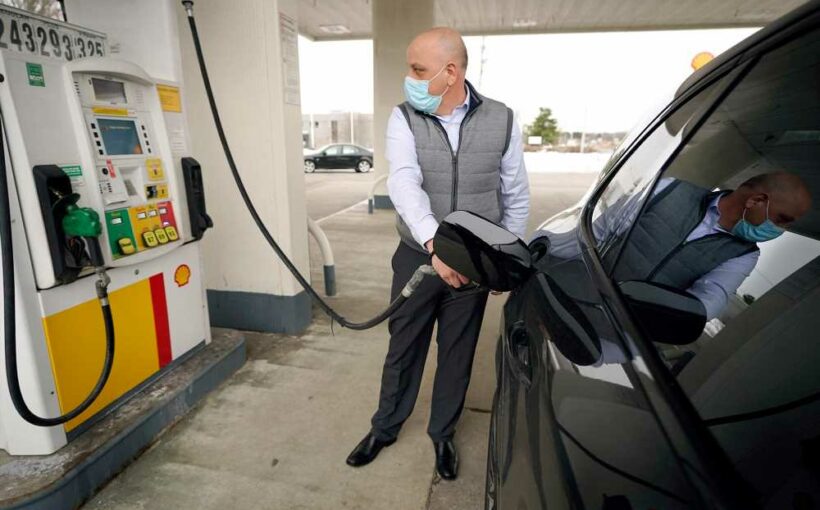More On:
inflation
Janet Yellen tells truth on economy — then quickly reverses herself
Yellin clarifies inflation comments after talk of rate hike roils Wall Street
Warren Buffett says US economy is ‘red hot’ but warns on inflation
$1 trillion? Why not $5 trillion! For progressives, the sky is no longer the limit on spending
Americans looking to spend a little money as they emerge from the pandemic are about to get pinched by rising prices everywhere they turn.
Consumers can expect to start forking over more — if they aren’t already — at grocery stores, coffee shops, drugstores, gas stations — and even on big ticket items like washing machines, consumer electronics and cars, economists say.
“We are seeing dramatic price increases now and we’ll see it spike between now and mid-summer,” warned Mark Zandi, chief economist at Moody’s Analytics. “Prices will be jumping and it’s wide-ranging.”
Procter & Gamble warned last month that it plans to raise prices on baby products, adult diapers and feminine-care brands by September. Gasoline prices, meanwhile, soared to $2.98 a gallon in April, up from $1.87 a year ago, just as people start planning their first summer vacations since 2019.
Cars are in such short supply that desperate vacationers in Hawaii were recently forced rented U-Hauls, according to reports.
In many ways, it’s a simple supply/demand problem. Consumers are emerging from the pandemic with fatter wallets thanks to a combination of stimulus checks and savings built up as they hunkered down at home. But their eagerness to spend that money is exceeding Corporate America’s ability to churn out goods amid a series of supply chain issues caused by the pandemic.
“The question,” said Andrew Hunter, senior US economist of Capital Economics, “is how long it will last.” The Federal Reserve “is trying to reassure everyone that it is a temporary trend linked to the reopening of the economy,” Hunter said. But there are signs that rising prices could linger for months or even years.
Boston retailer Yale Appliances, for example, recently warned customers that appliance prices by major brands from GE to Whirlpool could rise by 2.5 percent to 10 percent in the coming months. And prices aren’t expected to go down again until “late next year or early 2023,” according to Yale Appliance’s chief executive Steve Sheinkopf.
“The appliance supply chain is not designed to recover fast,” Sheinkopf explained in his April 16 post on the company’s website.
Even as the coronavirus loosens its grip on the US, it continues to wreak havoc on companies’ ability to access raw materials like metal, copper and wood pulp, as well as electronic parts like computer chips.
The chip shortage is roiling a wide range of industries from appliances to cars — and could soon drive up prices on consumer electronics like smart phones, game consoles and computers, experts say.
Apple in April said the chip shortage is hampering its production of iPads and Mac computers, a problem that could cost the company $3 billion to $4 billion in sales this quarter.
According to The Verge, the global semiconductor shortage — which has already led to consumer complaints that the newest PlayStation and Xbox gaming consoles have been hard to find — could go on for months, if not for the rest of 2021.
Millions of cars, meanwhile, are sitting idle in factory lots waiting for computer chips, according to reports. And car prices soaring as a result.
The average price of a new vehicle was up 6 percent to a record $40,578 as of December, according to data from Edmunds.com. The cost of a used car jumped far more, by 70 percent compared to a year ago, according to Zandi of Moody’s.
Car rental companies are normally big suppliers to the used car industry, but they dramatically shrunk their fleets last year due to falling demand. As travel picks up again, rental companies stand to make big money for the cars left on their lots — charging $200 a day in some cases.
Wood pulp is also in short supply amid a surge of pandemic-related home renovation projects coupled with fallout from Trump administration trade wars. It’s the cause of planned price hikes on a range of everyday items like diapers, toilet paper and tampons, experts say.
The wood pulp shortage has also resulted in an extra $24,000 cost for a new home, according to the National Association of Home Builders.
Grocery prices are up 3.5 percent over last year, well above the normal annual increase of 1 percent to 1.5 percent, amid surging transportation costs and consumer demand, according Hunter of Capital Economics.
Bloomberg News on Thursday reported that 50 of the 52 grocery categories tracked by NielsenIQ cost more than a year ago — with seafood prices up 18.7 percent in the 13-week period ended April 24.
According to the chief executive officer of Albertsons Cos., one reason for the jump is that grocers no longer have any reason to slash prices.
“When there’s a shortage in supply, it makes no sense to promote aggressively,” Vivek Sankaran told Bloomberg. “That’s why you see inflation in some categories. It just makes no sense to play with price at this point.”
Share this article:
Source: Read Full Article



